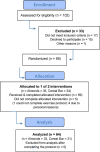Almond intake alters the acute plasma dihydroxy-octadecenoic acid (DiHOME) response to eccentric exercise
- PMID: 36698469
- PMCID: PMC9868138
- DOI: 10.3389/fnut.2022.1042719
Almond intake alters the acute plasma dihydroxy-octadecenoic acid (DiHOME) response to eccentric exercise
Abstract
Introduction: This investigation determined if 4-weeks ingestion of nutrient-dense almonds mitigated post-exercise inflammation and muscle soreness and damage.
Methods: An acute 90-min of eccentric exercise (90-EE) was used to induce muscle damage in 64 non-obese adults not engaging in regular resistance training (ages 30-65 years, BMI < 30 kg/m2). Using a parallel group design, participants were randomized to almond (AL) (57 g/d) or cereal bar (CB) (calorie matched) treatment groups for a 4-week period prior to the 90-EE (17 exercises). Blood and 24-h urine samples were collected before and after supplementation, with additional blood samples collected immediately post-90-EE, and then daily during 4 additional days of recovery. Changes in plasma oxylipins, urinary gut-derived phenolics, plasma cytokines, muscle damage biomarkers, mood states, and exercise performance were assessed.
Results: The 90-EE protocol induced significant muscle damage, delayed onset of muscle soreness (DOMS), inflammation, reduced strength and power performance, and mood disturbance. Interaction effects (2 group × 7 time points) supported that AL vs. CB was associated with reduced post-exercise fatigue and tension (p = 0.051, 0.033, respectively) and higher levels of leg-back strength (p = 0.029). No group differences were found for post-90-EE increases in DOMS and six cytokines. AL was associated with lower levels of serum creatine kinase immediately- and 1-day post-exercise (p = 0.034 and 0.013, respectively). The 90-EE bout increased plasma levels immediately post-exercise for 13 oxylipins. Interaction effects revealed significantly higher levels for AL vs. CB for 12,13-DiHOME (p < 0.001) and lower levels for 9,10-DiHOME (p < 0.001). Urine levels increased in AL vs. CB for seven gut-derived phenolics including 5-(3',4'-dihydroxyphenyl)-γ-valerolactone that was inversely related to changes in plasma 9,10-DiHOME (r = -0.029, p = 0.021).
Discussion: These data support some positive effects of almond intake in improving mood state, retaining strength, decreasing muscle damage, increasing the generation of gut-derived phenolic metabolites, and altering the plasma oxylipin DiHOME response to unaccustomed eccentric exercise in untrained adults. The elevated post-exercise plasma levels of 12,13-DiHOME with almond intake support positive metabolic outcomes for adults engaging in unaccustomed eccentric exercise bouts.
Keywords: (poly)phenols; almonds; cytokines; exercise; inflammation; metabolites; oxylipins.
Copyright © 2023 Nieman, Omar, Kay, Kasote, Sakaguchi, Lkhagva, Weldemariam and Zhang.
Conflict of interest statement
The authors declare that the research was conducted in the absence of any commercial or financial relationships that could be construed as a potential conflict of interest.
Figures






Similar articles
-
Blueberry intake elevates post-exercise anti-inflammatory oxylipins: a randomized trial.Sci Rep. 2023 Jul 24;13(1):11976. doi: 10.1038/s41598-023-39269-1. Sci Rep. 2023. PMID: 37488250 Free PMC article. Clinical Trial.
-
A Multiomics Evaluation of the Countermeasure Influence of 4-Week Cranberry Beverage Supplementation on Exercise-Induced Changes in Innate Immunity.Nutrients. 2024 Sep 26;16(19):3250. doi: 10.3390/nu16193250. Nutrients. 2024. PMID: 39408218 Free PMC article. Clinical Trial.
-
Antioxidants for preventing and reducing muscle soreness after exercise.Cochrane Database Syst Rev. 2017 Dec 14;12(12):CD009789. doi: 10.1002/14651858.CD009789.pub2. Cochrane Database Syst Rev. 2017. PMID: 29238948 Free PMC article.
-
Physical exercise training interventions for children and young adults during and after treatment for childhood cancer.Cochrane Database Syst Rev. 2016 Mar 31;3(3):CD008796. doi: 10.1002/14651858.CD008796.pub3. Cochrane Database Syst Rev. 2016. PMID: 27030386 Free PMC article.
-
Physical exercise training interventions for children and young adults during and after treatment for childhood cancer.Cochrane Database Syst Rev. 2013 Apr 30;(4):CD008796. doi: 10.1002/14651858.CD008796.pub2. Cochrane Database Syst Rev. 2013. Update in: Cochrane Database Syst Rev. 2016 Mar 31;3:CD008796. doi: 10.1002/14651858.CD008796.pub3. PMID: 23633361 Updated.
Cited by
-
Chronic almond nut snacking alleviates perceived muscle soreness following downhill running but does not improve indices of cardiometabolic health in mildly overweight, middle-aged, adults.Front Nutr. 2024 Jan 8;10:1298868. doi: 10.3389/fnut.2023.1298868. eCollection 2023. Front Nutr. 2024. PMID: 38260074 Free PMC article.
-
Influence of 2 Weeks of Mango Ingestion on Inflammation Resolution after Vigorous Exercise.Nutrients. 2023 Dec 21;16(1):36. doi: 10.3390/nu16010036. Nutrients. 2023. PMID: 38201866 Free PMC article. Clinical Trial.
-
Examination of Primary and Secondary Metabolites Associated with a Plant-Based Diet and Their Impact on Human Health.Foods. 2024 Mar 27;13(7):1020. doi: 10.3390/foods13071020. Foods. 2024. PMID: 38611326 Free PMC article. Review.
-
Blueberry intake elevates post-exercise anti-inflammatory oxylipins: a randomized trial.Sci Rep. 2023 Jul 24;13(1):11976. doi: 10.1038/s41598-023-39269-1. Sci Rep. 2023. PMID: 37488250 Free PMC article. Clinical Trial.
-
A Multiomics Evaluation of the Countermeasure Influence of 4-Week Cranberry Beverage Supplementation on Exercise-Induced Changes in Innate Immunity.Nutrients. 2024 Sep 26;16(19):3250. doi: 10.3390/nu16193250. Nutrients. 2024. PMID: 39408218 Free PMC article. Clinical Trial.
References
Grants and funding
LinkOut - more resources
Full Text Sources

